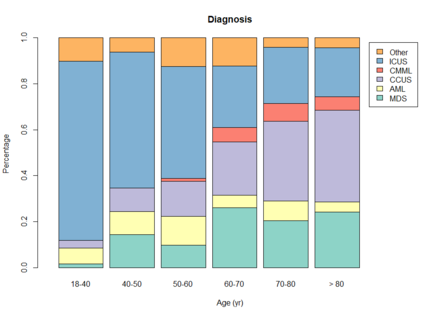
Contributions
Abstract: PB1615
Type: Publication Only
Session title: Myelodysplastic syndromes - Biology & Translational Research
Background
With increasing availability, next generation sequencing (NGS) is becoming a useful supplement in the diagnostic work up of patients with cytopenia.
Aims
This study aimed to improve the rational use of NGS by analyzing the occurrence of mutations in 593 patients with cytopenias from 2015-2020, referred for primary work up for a suspected hematological malignancy.
Methods
NGS of 20 genes associated with myeloid malignancies was performed in all patients, and 97% and 88% had a bone marrow biopsy and cytogenetics performed, respectively.
Results
Mutations were found in 311 (52.4%) patients and the most commonly mutated genes were TET2, DNMT3A, ASXL1, SRSF2 and SF3B1. Among patients with mutations, the most prominent diagnosis was CCUS (45%) followed by MDS (30%), AML (11%) and CMML (9%). The presence of one or more mutations increased the risk of having a malignant disorder diagnosed on the bone marrow (OR: 4.48, p < 0.0001). The median number of mutations per patient was one (range 0-12). High variant allele frequency was associated with abnormal bone marrow (p < 0.0001) with median VAF for MDS patients being 37% (IQR: 23%>44%), whereas patients with CCUS had a median VAF of 22% (9%>40%). Most patients presented with isolated cytopenia (42.7%), while 37.6% and 20.7% had bicytopenia and pancytopenia, respectively. The highest risk of mutations was in patients with bicytopenia, where 58.5% had at least one mutation. ICUS patients were the youngest, with a median age of 58 years (IQR: 43-70 yr) compared to 66 (51-73), 70 (64-77), 73 (67-78) and 71 (68-76) for AML, MDS, CCUS and CMML, respectively. We found a positive correlation between age and the risk of having a mutation, as the amount of patients with 1 or more mutations increased from 22% to 66%, regardless of final diagnosis, in age groups < 60 years and ≥ 60, respectively (OR: 7.0, p < 0.0001). In the age group above 60 years, CCUS was the most prominent diagnosis (32%), and 37% received a malignant hematological diagnosis (MDS, AML or CMML).

Conclusion
In conclusion, NGS can be a valuable tool in the diagnostic work up of patients with cytopenia, and CCUS is the most common disease in patients above 60 years referred due to unexplained cytopenia.
Keyword(s): Diagnosis, Mutation
Abstract: PB1615
Type: Publication Only
Session title: Myelodysplastic syndromes - Biology & Translational Research
Background
With increasing availability, next generation sequencing (NGS) is becoming a useful supplement in the diagnostic work up of patients with cytopenia.
Aims
This study aimed to improve the rational use of NGS by analyzing the occurrence of mutations in 593 patients with cytopenias from 2015-2020, referred for primary work up for a suspected hematological malignancy.
Methods
NGS of 20 genes associated with myeloid malignancies was performed in all patients, and 97% and 88% had a bone marrow biopsy and cytogenetics performed, respectively.
Results
Mutations were found in 311 (52.4%) patients and the most commonly mutated genes were TET2, DNMT3A, ASXL1, SRSF2 and SF3B1. Among patients with mutations, the most prominent diagnosis was CCUS (45%) followed by MDS (30%), AML (11%) and CMML (9%). The presence of one or more mutations increased the risk of having a malignant disorder diagnosed on the bone marrow (OR: 4.48, p < 0.0001). The median number of mutations per patient was one (range 0-12). High variant allele frequency was associated with abnormal bone marrow (p < 0.0001) with median VAF for MDS patients being 37% (IQR: 23%>44%), whereas patients with CCUS had a median VAF of 22% (9%>40%). Most patients presented with isolated cytopenia (42.7%), while 37.6% and 20.7% had bicytopenia and pancytopenia, respectively. The highest risk of mutations was in patients with bicytopenia, where 58.5% had at least one mutation. ICUS patients were the youngest, with a median age of 58 years (IQR: 43-70 yr) compared to 66 (51-73), 70 (64-77), 73 (67-78) and 71 (68-76) for AML, MDS, CCUS and CMML, respectively. We found a positive correlation between age and the risk of having a mutation, as the amount of patients with 1 or more mutations increased from 22% to 66%, regardless of final diagnosis, in age groups < 60 years and ≥ 60, respectively (OR: 7.0, p < 0.0001). In the age group above 60 years, CCUS was the most prominent diagnosis (32%), and 37% received a malignant hematological diagnosis (MDS, AML or CMML).

Conclusion
In conclusion, NGS can be a valuable tool in the diagnostic work up of patients with cytopenia, and CCUS is the most common disease in patients above 60 years referred due to unexplained cytopenia.
Keyword(s): Diagnosis, Mutation


